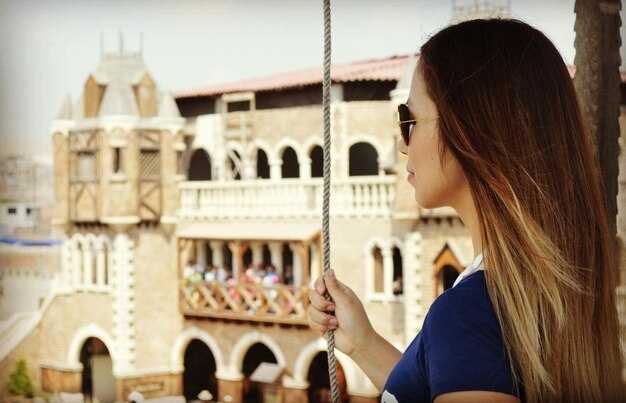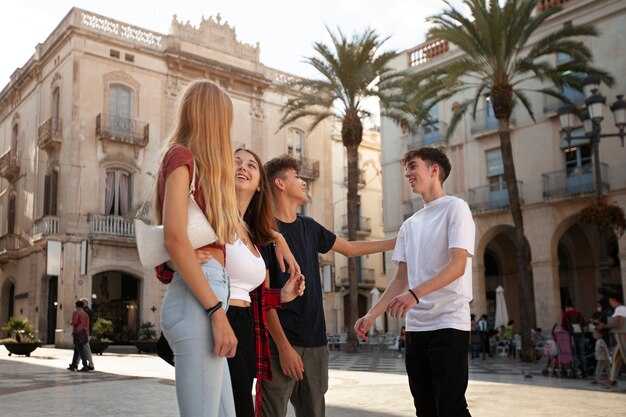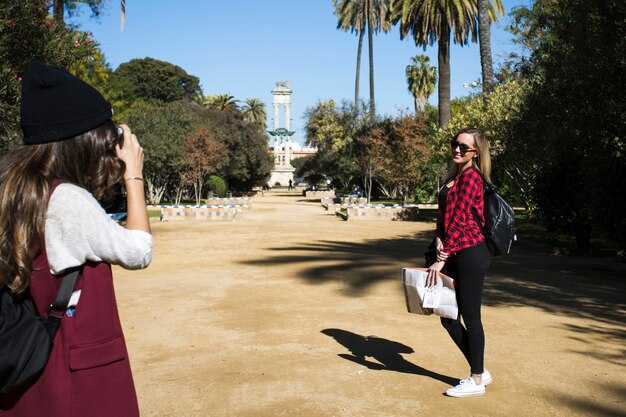Book Sagrada Família slots online for a morning window and pair it with a quick stroll through the Gothic Quarter. theres a simple reason: you’ll dodge those long lines, and the light through the stained glass looks best early. For those who love details, check the official site for ticket details and add a rooftop option if you can.
After the Gothic Quarter, ride the metro to Gràcia, which feels like a village in a big city. In this european hub, stroll quiet plazas, snack on pan con tomate, and photograph the green detailing on modernist façades along Passeig de Gràcia–an eye-catching contrast to the stained-glass interiors you just visited.
For outdoor scenery, head to Park Güell early or wander the terraces around Montjuïc; use transport on metro L3 or bus lines to reach the top. There you’ll find a mix of gardens and city views, and you can plan several trips to nearby places without rushing.
In the city center, La Boqueria market offers fresh juice and seafood, but the crowds can be intense around midday. A quick comment from locals: visit early or after 2 pm for a calmer experience. If you’re shopping, doing a quick stroll through El Born reveals hidden courtyards and small ateliers.
Flight tip: if you fly with easyjet, land at Barcelona El Prat and take the Aerobus or train to the city center in 20–35 minutes. Booking ahead saves time. In the evening, some galleries and bars host live shows; reserve a table or ticket if you want a guaranteed seat. This makes the evening truly memorable if you time it with a stroll along the waterfront.
Stay near Eixample for easy transit to most places, then wander the center at night for a calmer scene; there’s a village vibe in Gràcia and its square life keeps that human scale totally intact. Locals might refer to the Sagrada Familia simply as familia among friends, a small reminder of how the city folds iconic landmarks into daily life.
Best public transport options from Barcelona Airport to the city center
Take the Renfe R2 Nord train from Barcelona–El Prat to Barcelona Sants. This option is fast, comfortable, and economical, with a small footprint compared with a taxi. Trains run frequently, and you reach the citys center in about 20–25 minutes to Sants or 25–30 minutes to Passeig de Gràcia. Buy a single-ride ticket at the station machines, or use a card if you have a travel card; this keeps things simple if you plan several rides. Locals rely on this line for reliability, and it’s an easy start to a day of sightseeing across the city, ideal for building collections of sights you want to see, or getting to your house or hotel in the citys center.
Aerobus is the direct bus from both terminals to Plaça Catalunya. It typically takes around 35 minutes, depending on traffic, and runs frequently during the day. Tickets cost roughly €6–€7 one-way and can be bought at the kiosk or on board. This option suits travelers with small luggage or those who want to drop straight into the iconic city center near the seafront. It avoids stairs and transfers, making the approach comfortable for first-time visitors. If you compare routes with paris, you may notice Barcelona’s network has its own rhythm.
Practical tips
Rule of thumb: if you want speed with minimal transfers, pick the Renfe line; if you prefer a direct route with less risk of delays, choose the Aerobus. There are plenty of options to buy tickets, and both routes show clear signage in multiple European languages. You can find features like luggage space on Renfe and frequent staff help on Aerobus. For longer stays, consider a travel card for flexibility, though check whether it covers airport connections. This approach helps you settle into the citys rhythm and gives you a comfortable start to your favorite neighborhoods throughout your european stay.
Where to stay near Bellsguard Casa Figueres: neighborhoods and price ranges
Base yourself in Gràcia for easy access to Bellsguard Casa Figueres, a lovely base with local tapas, helpful guidance, and languages spoken by hosts. This citys neighborhood keeps crowds manageable while tourists enjoy a real Barcelona experience. Stays range from €70-€110 for budget studios, €110-€180 for mid-range apartments, and €180-€260 for boutique options.
-
Gràcia: A lively, walkable core with plazas like Plaça del Sol and plenty of tapeo options after sunset. It’s a short ride to Bellsguard Casa Figueres, and you avoid the heaviest crowds you’ll find in the Gothic Quarter. Expect a mix of budget hostels, family-run apartments, and boutique hotels. Price ranges: €70-€110 (budget), €110-€180 (mid-range), €180-€260 (upscale).
-
Sarrià-Sant Gervasi: A calmer, leafy district that feels almost fortress-like in parts, with plenty of boutique houses and family-friendly stays. Direct connections to gaudi sites make day trips straightforward. Staff often speak languages including English and german; some hosts run places with names like louis, giving a personal touch. Price ranges: €90-€130 (budget), €130-€210 (mid-range), €210-€350 (luxury).
-
Eixample: Central and elegant, ideal for antoni gaudiMasterpiece access with the famous gaudi works within easy reach. You’ll find reliable service, stylish apartments, and generous breakfast options. Price ranges: €60-€110 (budget), €110-€180 (mid-range), €190-€320 (upscale).
-
Les Corts: A practical base with strong transport links, quiet evenings, and good value for families and groups. It’s a short ride to Gràcia’s tapeo routes and to Bellsguard Casa Figueres. Price ranges: €80-€120 (budget), €120-€190 (mid-range), €190-€300 (luxury).
Tips: reserve early for peak periods to save and to avoid crowds. Consider mixing stays to balance citys energy with restful mornings, and use guidance from multilingual hosts to tailor your experiences around antoni gaudi masterpiece and beyond. This approach helps you enjoy lovely house stays, masterworks, and the citys vibrant experiences, together with friends or family.
Gaudí highlights with ticket tips: Sagrada Família, Park Güell, Casa Batlló
Book timed-entry online for all three sites to lock in preferred hours; tickets are limited and sell out, especially in peak seasons, so plan ahead and consider a viator option to secure slots. This approach follows the recommendations for a smooth day and helps you make the most of Barcelona’s Gaudí highlights.
Sagrada Família: tickets and tips
Standard entry sits around €29 and tower access adds about €12; the total for a visit with tower access is probably higher, so read the exact prices online before you go. Choose morning or late afternoon slots to avoid peak crowds and strong sun. reading the official site helps you pick the best times, and the interior lighting highlights the curves of the columns and vaults. For a person traveling solo or with a small group, the experience stays intimate, and the space feels lively as the light shifts. If you have a Barcelona Card or other pass, check whether it provides any discount or skip-the-line benefit; availability is limited. After the visit, a classic dining option nearby offers quick bites and traditional dishes; tiny cafés around the precinct provide fair, well-priced options to keep you energized. In addition, a guided option provides context about the architecture, and recommendations from locals can help you plan the rest of the day.
Park Güell and Casa Batlló: timing, mosaics, and dining

Park Güell Monumental Zone tickets are about €12 with timed entry; hours vary by season but typically run from morning to early evening, with evening slots offering soft light for photos. The mosaic dragon, terrace mosaics, and the long curved benches showcase Gaudí’s curves and tiny details that visitors love. The area around the park feels lively, and residents and locals often stroll by after work. Outside the Monumental Zone, the free areas remain busy with activities and street life, so plan 60–90 minutes to take in the main sights. For dining, a cluster of tiny cafés and classic eateries along the surrounding streets offers quick bites and Catalan specialties. You can book via viator for combined tickets or guided experiences that include the Casa Batlló interior, with typical prices around €34–€40 for the standard visit; Batlló by Night and other guided options provide different lighting and storytelling follows the design narrative. The Batlló house is housed on Passeig de Gràcia, a short walk from fine dining and lively shops; end the day with a stroll along the avenue to sample more local culture. If you use a city card, check for skip-the-line benefits; locals often pair the Batlló visit with a late dinner, which helps you stay in the rhythm of the city. thanks for reading.
Art and culture beyond Gaudí: Picasso, Dalí, and modern museums
Begin with the Picasso Museum in El Born–this must-see opener anchors your art day. book tickets online to avoid lines, and arrive on arrival to catch the early galleries at a comfortable pace. The central location puts you close to Montcada’s medieval façades and a church spire that defines the old town, with evenings bringing a lively atmosphere to nearby cafés. The city shows gaudi influence in tilework and street furniture, a nice reminder that Barcelona’s design spirit threads across eras. The Picasso collection traces his early studies toward paris, offering a clear path into the broader modern scene.
Dalí: a day trip that deepens the surreal thread
For Dalí, plan a day trip to Figueres to visit the Dalí Theatre-Museum, officially opened in 1974. The striking exterior and labyrinthine interiors feel like a dream you can walk through, a strong contrast to the more restrained geometry of gaudi-inspired architecture. The façade features a torre visible from the street. Take a fast train from Barcelona Sants; the arrival in Figueres takes about 1.5 hours, and you should allocate 2–3 hours inside. The show follows Dalí’s paris years and his Catalan roots, with prominent works that stay with you long after the visit, experiencing the humor and tension in his images. German visitors and local residents alike savor this experience, often pairing it with a stroll through the old town. If a day trip is not feasible, look for Dalí exhibitions in Barcelona’s museums as an additional option, and consider a city pass for multiple venues. A note by vella in the guide clarifies the flow of rooms and pacing. That contrast gives you a strong feeling of space.
Modern museums: MACBA, CCCB, and beyond

From here, switch to MACBA in the central Raval, where bright, open spaces host postwar and contemporary work by artists from around the world. The adjacent CCCB offers dynamic programs–film, design, and urban culture–in a compact footprint that mirrors the city’s pulse. For a broader arc, add the Fundació Joan Miró on Montjuïe and the Fundació Antoni Tàpies in Eixample to your route; the buildings themselves feel prominent and invite contemplation. The walk between sites takes you through narrow streets and pleasant plazas, with cactuses in planters along some courtyards adding a touch of color to warm spaces. If you stay in a hotel nearby, you’ll likely find a rhythm: mornings at the museums, afternoons at markets or workshops, and evenings in central squares or a nice rooftop bar. Officially, these venues coordinate programs that respond to residents and visitors alike, and the Paris-inspired experimentation is easy to feel in Barcelona’s art scene, hence the lasting appeal for arriving travelers.
Eat like a local: top tapas bars and market bites in Gothic Quarter and El Born
Kick off in El Born at El Xampanyet for cava and bombas that hit the heart of local dining. The space is designed with a lively, intricate vibe, and as you wander, you’ll feel the same warmth in every corner of the bar and the adjacent streets. They serve clean, simple tapas with a Spanish spirit that makes you want to return for more.
In the Gothic Quarter, markets bridge the old world with modern flavors. At La Boqueria, Bar Pinotxo sits alongside the Rambla’s flow, and the proximity close to the Rambla means you’ll meet both locals and visitors in the same moment. The chef’s hands work quickly with market-fresh ingredients, turning humble things into small plates that become a memorable experience. The building, the rohe-tiled counters, and the aroma of seafood and vegetables create an amazing first bite of the day or a late-night snack.
- El Xampanyet (El Born) – a beloved cava-centric spot with anchovies, olives, and bombas. The interior’s tiled design and copper taps feel timeless, and the heart of its crowd makes it a perfect starting point for your walk toward the Rambla and beyond.
- Bar Pinotxo (La Boqueria, La Rambla) – inside the market, this is where generations of cooks have turned market bits into quick delights. Ask for a small plate with chickpeas or a simple seafood touch; you’ll taste the soul of the market in every bite.
- La Plata (Gothic Quarter) – tiny, legendary, and always worth a stop. Four dishes rotate daily, so you’ll find fresh, unobtrusive tapas that pair perfectly with a cold beer after a day of wandering the same stone streets and towers nearby.
- Tapeo Born (El Born) – a lively, compact spot known for seasonal bites and a straightforward, honest menu. It’s the kind of place where you share stories and racks of plates, and you leave with a fuller sense of the neighborhood’s rhythm.
- Santa Caterina Market stalls (near El Born) – the colorful roof marks the spot, and the stalls offer a quick collapse of Iberian ham, cheeses, and fresh bites. It’s perfect for a quick pause, a glass of vermouth, and a stroll that leads you toward Peratallada-style stone façades and the intimate spaces of surrounding streets.
Tips to sharpen the experience: go with a small pace so you can wander between spaces, building a route that feels like a bridge between markets and intimate bars. Look for a Peratallada-inspired stone façade on a corner building and let the textures of trees, close quarters, and ancient stones enhance your appetite. Ask for the staff’s recommendations in Spanish or Catalan; they’ll appreciate the effort and you’ll improve your chances of discovering something you’ll want to tell a friend about. If you’re a lover of Europe’s casual dining, this route is designed to heighten your sense of place and taste in one captivating evening.
Want to finish with a nightcap? Slip into a quiet bar near the Rambla or a hidden courtyard in the Gothic Quarter to cap the experience with a Spanish vermouth or a glass of cava. The heart of the district beats in these spaces, and it’s the same energy that makes every bite feel special. Thank you for reading–enjoy your time in Barcelona’s streets, where every corner builds a memory you’ll carry home.
One-day vs. two-day plan: fit landmarks and neighborhoods without rush
Two days let you savor masterpieces and the atmosphere without rush; a customizable rhythm lets you enjoy both iconic sights and hidden corners, marveling at the skyline, the line of palm trees, and the Vicens-influenced details along the avenues. If you arrived by flights, a well-chosen hotel base reduces logistics and keeps rates fair, while giving you time to rest between blocks.
하루 일정의 경우, 빡빡한 루프를 계획하세요. 사전 예약 티켓으로 사그라다 파밀리아에서 시작하여, 카사 바트요와 라 페드레라를 보기 위해 그라시아 거리를 따라 산책하고, 고딕 지구를 돌아다니며 서고트 시대의 성벽을 구경한 다음, 산트 안토니에서 요리 수업으로 마무리하세요. 환승을 최소화하기 위해 L2 또는 L3 노선을 따라 이동하고, 편안한 속도를 유지하며, 커피를 마시며 짧은 휴식을 계획하여 자신이나 다른 사람이 지치지 않도록 하세요. 또한 처음 여행하는 사람에게 가장 중요할 가능성이 높은 부분을 공략하는 합리적인 경로를 고수하여 관광객 함정을 피할 수 있습니다.
이틀 계획: 동네와 걸작을 음미하다
첫째 날은 바리 고틱, 엘 보른, 산트 안토니에 중점을 두고 피카소 미술관이나 미로 미술관 전시회를 방문합니다. 저녁에는 카스텔 시연이 있어 서두르지 않고도 경이로움을 느낄 수 있는 환상적인 볼거리를 제공합니다. 둘째 날은 에이샴플레와 그라시아로 이동하여 디자인 걸작들이 아늑한 광장과 요리 장소 옆에 자리 잡고 있습니다. 카사 비센스(vicens)와 기타 주요 명소를 방문한 다음 스카이라인을 다시 보여주고 마치 한 도시에서 여러 마을을 여행한 듯한 느낌을 주는 옥상 전망으로 마무리합니다.
초심자를 위한 실용적인 여행 팁: 교통 패스, 안전, 짐 싸기
예상 지출을 책정하고 유연한 여행 일정을 계획할 수 있도록 3일간의 올라는 바르셀로나 트래블 카드를 구매하여 대중교통을 무제한으로 이용하세요.
대부분의 처음 방문객에게는 3~4일권으로 바리 고틱, 에이샴플, 그라시아와 같은 핵심 지역 간의 이동과 해안으로의 빈번한 연결을 커버할 수 있습니다. 짧은 구간 이동이 많을 것으로 예상된다면 T-Casual(10회 탑승)로 비용을 절약할 수 있지만 티켓 관리가 더 잦아집니다. 계획에 따른 총액을 비교하고 휴대해야 하는 티켓 수를 최소화하는 옵션을 선택하세요.
주요 역의 공식 데스크, 공항 또는 검증된 온라인 소스를 통해 구매하세요. 활성화는 빠르며, 기기나 카드를 통해 충전할 수 있습니다. 투어 또는 체험을 예약한 경우, 막바지 수수료를 피하기 위해 사전에 취소 조건을 검토하십시오. 대중교통 패스는 일반적으로 취소가 필요하지 않지만 일부 추가 활동은 필요합니다.
안전 및 포장
바르셀로나의 번잡한 지역(라 람블라, 고딕 홀 복도, 교통 허브)에는 인파가 몰리므로 안전한 가방과 앞주머니 휴대로 돈을 보호하세요. 지퍼 잠금 장치를 사용하고, 귀중품을 눈에 띄지 않게 보관하고, 구불구불한 통로에서 원치 않는 도움을 제공하는 낯선 사람들을 경계하세요. 정류장을 놓치거나 방향이 확실하지 않은 경우 사람이 많은 곳으로 가서 낯선 사람을 따라가지 말고 지도를 다시 확인하십시오.
가볍지만 완전하게 짐을 꾸리세요: 작은 배낭, 가벼운 레인 재킷, 편안한 운동화, 재사용 가능한 물병. 시장과 길거리 상인을 위한 소량의 현금, 보조 배터리, 유니버설 어댑터, 거주 문서 사본 또는 디지털 백업을 포함하세요. 숄이나 랩은 도시의 가로수가 늘어선 거리에서 서늘한 저녁 시간 동안 콘서트홀과 교회에서 유용합니다.
저녁 외출이나 박물관 방문을 계획할 때 긴 줄을 피하기 위해 티켓 수령 및 입장 시간을 확인하세요. 콘서트나 이벤트를 계획하는 경우, 보안 검색대를 통과하고 사전에 좌석을 찾기 위해 일찍 도착하세요. 특히 늦은 공연이 있는 날에는 더욱 도움이 됩니다.
| 주제 | 팁 | 참고 |
|---|---|---|
| 대중교통 패스 | 일정에 따라 2~5일을 선택하세요. | Hola Barcelona Travel Card는 무제한 대중교통을 제공합니다. T-Casual은 10회 탑승 가능합니다. |
| 안전 | 귀중품을 안전하게 보관하세요. 앞주머니나 크로스바디 가방을 이용하세요. | 혼잡한 홀과 밤에는 조심하십시오 |
| Packing | 가벼운 장비, 어댑터, 물병, 서류 사본 | 시장을 위해 약간의 돈을 포함시키세요 |



댓글